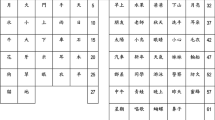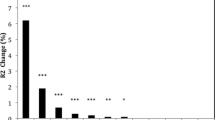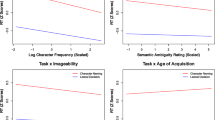Abstract
We examined the relationship between rapid naming speed (RAN) and Chinese character recognition accuracy and fluency. Sixty-three grade 2 and 54 grade 4 Taiwanese children were administered four RAN tasks (colors, digits, Zhu-Yin-Fu-Hao, characters), and two character recognition tasks. RAN tasks accounted for more reading variance in grade 4 than in grade 2, and graphological RAN tasks accounted for more reading variance than RAN Colors. After controlling for age, nonverbal intelligence, phonological sensitivity, short-term memory, and orthographic processing, RAN tasks were significant predictors of character recognition fluency in grade 2, and of both accuracy and fluency in grade 4.
Similar content being viewed by others
References
Blachman, B. A. (1984). Relationship of rapid naming ability and language analysis skills to kindergarten and first-grade reading achievement. Journal of Educational Psychology, 76, 610–622.
Bowers, P. G. (1995). Tracing symbol naming speed’s unique contributions to reading disability over time. Reading and Writing: An Interdisciplinary Journal, 7, 189–216.
Bowers, P. G., Golden, J. O., Kennedy, A., & Young, A. (1994). Limits upon orthographic knowledge due to processes indexed by naming speed. In V. W. Berninger (Ed.), The varieties of orthographic knowledge: Theoretical and developmental issues (pp. 173–218). Dordrecht: Kluwer Academic Publishers.
Bowers, P. G., & Newby-Clarke, E. (2002). The role of naming speed within a model of reading acquisition. Reading and Writing: An Interdisciplinary Journal, 15, 109–126.
Bowers, P. G., & Swanson, L. B. (1991). Naming speed deficits in reading disability. Journal of Experimental Child Psychology, 51, 195–219.
Bowers, P. G., & Wolf, M. (1993). Theoretical links among naming speed, precise timing mechanisms and orthographic skill in dyslexia. Reading and Writing: An Interdisciplinary Journal, 5, 69–85.
Bowey, J. A., McGuigan, M., & Ruschena, A. (2005). On the association between serial naming speed for letters and digits and word-reading skill: Towards a developmental account. Journal of Research in Reading, 28, 400–422.
Caravolas, M. (2006). The foundations of literacy in Czech: Not so different from English after all? Paper presented at the 11th annual conference of the Society for the Scientific Studies of Reading. Canada: Vancouver.
Cardoso-Martins, C., & Pennington, B. F. (2004). The relationship between phoneme awareness and rapid serial naming skills and literacy acquisition: The role of developmental period and reading ability. Scientific Studies of Reading, 8, 27–52.
Chan, L., & Wang, L. (2003). Linguistic awareness in learning to read Chinese: A comparative study of Beijing and Hong Kong children. In C. McBride-Chang & H.-C. Chen (Eds.), Reading development in Chinese children (pp. 91–106). Westport, CT: Praeger.
Chen, M. J. (2003). Component skills for reading Chinese in primary school children. In C. McBride-Chang & H.-C. Chen (Eds.), Reading development in Chinese children (pp. 19–33). Westport, CT: Praeger.
Cheung, H., McBride-Chang, C., & Chow, B. W.-Y. (2006). Reading Chinese. In R. M. Joshi & P. G. Aaron (Eds.), Handbook of orthography and literacy (pp. 421–438). Mahwah, NJ: Erlbaum.
Chow, B. W.-Y., McBride-Chang, C., & Burgess, S. (2005). Phonological processing skills and early reading abilities in Hong Kong Chinese kindergarteners learning to read English as a second language. Journal of Educational Psychology, 97, 81–87.
Clarke, P., Hulme, C., & Snowling, M. J. (2005). Individual differences in RAN and reading: A response timing analysis. Journal of Research in Reading, 28, 73–86.
Compton, D. L. (2003). Modeling the relationship between growth in rapid naming speed and growth in decoding skill in first-grade children. Journal of Educational Psychology, 95, 225–239.
de Jong, P. F., & van der Leij, A. (1999). Specific contributions of phonological abilities to early reading acquisition: Results from a Dutch latent variable longitudinal study. Journal of Educational Psychology, 91, 450–476.
Empirisoft Corporation (2006). DirectRT Research Software (v2004). New York: Empirisoft.
Felton, R. H., Naylor, C. E., & Wood, F. B. (1990). Neuropsychological profile of adult dyslexics. Brain and Language, 39, 485–497.
Georgiou, G., Parrila, R., & Kirby, J. (2006). Rapid naming speed components and early reading acquisition. Scientific Studies of Reading, 10, 199–220.
Glass, G. V., & Hopkins, K. D. (1984). Statistical methods in education and psychology (2nd ed.). Englewood Cliffs, NJ: Prentice-Hall.
Ho, C. S.-H., & Bryant, P. (1997a). Learning to read Chinese beyond the logographic phase. Reading Research Quarterly, 32, 276–289.
Ho, C. S.-H., & Bryant, P. (1997b). Phonological skills are important in learning to read Chinese. Developmental Psychology, 33, 946–951.
Ho, C. S.-H., Chan, D. W.-O., Lee, S.-H., Tsang, S.-M., & Luan, V. H. (2004). Cognitive profiling and preliminary subtyping in Chinese developmental dyslexia. Cognition, 91, 43–75.
Ho, C. S.-H., Chan, D., Tsang, S.-M., & Lee, S.-H. (2000). The Hong Kong test of specific learning difficulties in reading and writing. Hong Kong: Hong Kong Specific learning Difficulties Research Team.
Ho, C. S.-H., Chan, D. W.-O., Tsang, S.-M., & Lee, S.-H. (2002). The cognitive profile and multiple-deficit hypothesis in Chinese developmental dyslexia. Developmental Psychology, 38, 543–553.
Ho, C. S.-H., & Lai, D. N.-C. (1999). Naming-speed and phonological memory deficits in Chinese developmental dyslexia. Learning and Individual Differences, 11, 173–186.
Ho, C. S.-H., Ng, T.-T., & Ng, W.-K. (2003). A “radical” approach to reading development in Chinese: The role of semantic radicals and phonetic radicals. Journal of Literacy Research, 35, 849–878.
Ho, C. S.-H., Yau, P. W.-Y., & Au, A. (2003). Development of orthographic knowledge and its relationship with reading and spelling among Chinese kindergarten and primary school children. In C. McBride-Chang & H.-C. Chen (Eds.), Chinese children’s reading development (pp. 51–71). New Haven, CT: Greenwood.
Hoosain, R. (1991). Psycholinguistic implications for linguistic relativity: A case study of Chinese. Hillsdale, NJ: Lawrence Erlbaum Associates.
Hu, C.-F., & Catts, H. W. (1998). The role of phonological processing in early reading ability: What we can learn from Chinese. Scientific Studies of Reading, 2, 55–79.
Huang, H. S., & Hanley, J. R. (1995). Phonological awareness and visual skills in learning to read Chinese and English. Cognition, 54, 73–98.
Huang, H., & Hanley, J. (1997). A longitudinal study of phonological awareness, visual skills, and Chinese reading acquisition among first-graders in Taiwan. International Journal of Behavioral Development, 20, 249–268.
Huang, H.-S. (2001). Graded Chinese character recognition test. Taipei, Taiwan: Psychology Publication.
Ju, D., & Jackson, N. E. (1995). Graphic and phonological processing in Chinese character identification. Journal of Reading Behavior, 27, 299–313.
Kang, C. (2004). Phonological awareness and naming speed in good and poor Chinese readers. Unpublished master’s thesis, University of Hong Kong, China.
Katzir, T., Kim, Y., Wolf, M., O’Brien, B. K., Lovett, M., & Morris, R. (2006). Reading fluency: The whole is more than the parts. Annals of Dyslexia, 56, 51–82.
Kirby, J. R., Parrila, R., & Pfeiffer, S. L. (2003). Naming speed and phonological awareness as predictors of reading development. Journal of Educational Psychology, 95, 453–464.
Levelt, W., Roelofs, A., & Meyer, A. S. (1999). A theory of lexical access in speech production. Behavioral and Brain Sciences, 22, 1–75.
Lu, T.-H. (2003). The relationship of phonological processing (phonological awareness, verbal short-term memory, and rapid naming) and visual short-term memory to reading disabilities in Chinese children. Unpublished doctoral dissertation, University of Iowa, Iowa City.
Manis, F. R., Doi, L. M., & Bhadha, B. (2000). Naming speed, phonological awareness, and orthographic knowledge in second graders. Journal of Learning Disabilities, 33, 325–333.
Manis, F. R., Seidenberg, M. S., & Doi, L. M. (1999). See Dick RAN: Rapid naming and the longitudinal prediction of reading subskills in first and second graders. Scientific Studies of Reading, 3, 129–157.
Mann, V., & Wimmer, H. (2002). Phoneme awareness and pathways into literacy: A comparison of German and American children. Reading and Writing: An Interdisciplinary Journal, 15, 653–682.
Mayringer, H., Wimmer, W., & Landerl, K. (1998). Phonological skills and literacy acquisition in German. In P. Reitsma, & L. Verhoeven (Eds.), Problems and interventions in literacy development (pp. 147–161). Dordrecht, The Netherlands: Kluwer Academic Publishers.
McBride-Chang, C., Chow, B. W.-Y., Zhong, Y., Burgess, S., & Hayward, W. G. (2005). Chinese character acquisition and visual skills in two Chinese scripts. Reading and Writing: An Interdisciplinary Journal, 18, 99–128.
McBride-Chang, C., & Ho, C. S.-H. (2000). Developmental issues in Chinese children’s character acquisition. Journal of Educational Psychology, 92, 50–55.
McBride-Chang, C., & Kail, R. V. (2002). Cross-cultural similarities in the predictors of reading acquisition. Child Development, 73, 1392–1407.
McBride-Chang, C., Shu, H., Zhou, A., Wat, C. P., & Wagner, R. K. (2003). Morphological awareness uniquely predicts young children’s Chinese character recognition. Journal of Educational Psychology, 95, 743–751.
McBride-Chang, C., & Zhong, Y. (2003). A longitudinal study of effects of phonological processing, visual skills, and speed of processing on Chinese character acquisition among Hong Kong Chinese kindergartners. In C. McBride-Chang & H.-C. Chen (Eds.), Reading development in Chinese children (pp. 37–49). Westport, CT: Praeger.
Müller, K., & Brady, S. (2001). Correlates of early reading performance in a transparent orthography. Reading and Writing: An Interdisciplinary Journal, 14, 757–799.
Naglieri, J. A., & Das, J. P. (1997). Das-Naglieri cognitive assessment system. Itasca, IL: Houghton Mifflin.
Neuhaus, G., Foorman, B. R., Francis, D. J., & Carlson, C. D. (2001). Measures of information processing in rapid automatized naming (RAN) and their relation to reading. Journal of Experimental Child Psychology, 78, 359–373.
Nikolopoulos, D., Goulandris, N., Hulme, C., & Snowling, M. J. (2006). The cognitive bases of learning to read and spell in Greek: Evidence from a longitudinal study. Journal of Experimental Child Psychology, 94, 1–17.
Pak, A., Cheng-Lai, A., Tso, I., Shu, H., Li, W., & Anderson, R. (2005). Visual chunking skills of Hong Kong Children. Reading and Writing: An Interdisciplinary Journal, 18, 437–454.
Parrila, R., Kirby, J. R., & McQuarrie, L. (2004). Articulation rate, naming speed, verbal short-term memory, and phonological awareness: Longitudinal predictors of early reading development? Scientific Studies of Reading, 8, 3–26.
Patel, T., Snowling, M. J., & de Jong, P. F. (2004). A cross-linguistic comparison of children learning to read in English and Dutch. Journal of Educational Psychology, 96, 785–797.
Pedhazur, E. G. (1982). Multiple regression in behavioral research: Explanation and prediction (2nd ed.). New York: CBS College Publishing.
Savage, R., & Frederickson, N. (2005). Evidence of a highly specific relationship between rapid automatic naming of digits and text-reading speed. Brain and Language, 93, 152–159.
Scarborough, H. S. (1998). Predicting the future achievement of second graders with reading disabilities: Contributions of phonemic awareness, verbal memory, rapid naming, and IQ. Annals of Dyslexia, 48, 115–136.
Schatschneider, C., Fletcher, J. M., Francis, D. J., Carlson, C. D., & Foorman, B. R. (2004). Kindergarten prediction of reading skills: A longitudinal comparative analysis. Journal of Educational Psychology, 96, 265–282.
Shen, H. H., & Bear, D. R. (2000). Development of orthographic skills in Chinese children. Reading and Writing: An Interdisciplinary Journal, 13, 197–236.
Shu, H. (2003). Chinese writing system and learning to read. International Journal of Psychology, 38, 274–285.
Shu, H., & Anderson, R. C. (1997). Role of radical awareness in the character and word acquisition of Chinese children. Reading Research Quarterly, 32, 78–89.
Shu, H., & Anderson, R. C. (1999). Learning to read Chinese: The development of metalinguistic awareness. In J. Wang, A. W. Inhoff & H.-C. Chen (Eds.), Reading Chinese script: A cognitive analysis (pp. 1–18). Mahwah, NJ: Lawrence Erlbaum Associates.
Siok, W. T., & Fletcher, P. (2001). The role of phonological awareness and visual-orthographic skills in Chinese reading. Developmental Psychology, 37, 886–899.
Tabachnick, B., & Fidell, L. (2001). Using multivariate statistics (4th ed.). Boston: Allyn and Bacon.
Tan, L. H., Spinks, J. A., Eden, G. F., Perfetti, C. A., & Siok, W. T. (2005). Reading depends on writing, in Chinese. Proceedings of The National Academy of Sciences of The United States of America, 102, 8781–8785.
Theios, J., & Amrhein, P. C. (1989). Theoretical analysis of the cognitive processing of lexical and pictorial stimuli: Reading, naming, and visual and conceptual comparisons. Psychological Review, 96, 5–24.
Torgesen, J. K., Wagner, R. K., & Rashotte, C. A. (1994). Longitudinal studies of phonological processing and reading. Journal of Learning Disabilities, 27, 276–286.
Torgesen, J. K., Wagner, R. K., Rashotte, C. A., Burgess, S., & Hecht, S. (1997). Contributions of phonological awareness and rapid automatic naming ability to the growth of word-reading skills in second-to fifth-grade children. Scientific Studies of Reading, 1, 161–185.
Uhry, J. K. (2002). Kindergarten phonological awareness and rapid serial naming as predictors of Grade 2 reading and spelling. In E. Witruk, A. D. Friederici & T. Lachmann (Eds.), Basic functions of language, reading, and reading disability (pp. 299–313). Boston: Kluwer Academic Publishers.
van den Bos, K., Zijlstra, B. J., & lutje-Spelberg, H. (2002). Life-span data on continuous-naming speeds of numbers, letters, colors, and pictured objects, and word-reading speed. Scientific Studies of Reading, 6, 25–49.
Wagner, R. K., & Torgesen, J. K. (1987). The nature of phonological processing and its causal role in the acquisition of reading skills. Psychological Bulletin, 101, 192–212.
Wagner, R., Torgesen, J., Rashotte, C. A, Hecht, S., Barker, T., Burgess, T., et al. (1997). Changing relations between phonological processing abilities and word-level reading as children develop from beginning to skilled readers: A 5-year longitudinal study. Developmental Psychology, 33, 468–479.
Wang, Q. (2005). Predicting Chinese children’s reading development from kindergarten to second grade. Unpublished Doctoral Dissertation, University of Illinois at Urbana-Champaign, USA.
Wolf, M., & Bowers, P. G. (1999). The double-deficit hypothesis for the developmental dyslexia. Journal of Educational Psychology, 91, 415–438.
Wolf, M., Bowers, P. G., & Biddle, K. (2000). Naming-speed processes, timing, and reading: A conceptual review. Journal of Learning Disabilities, 33, 387–407.
Yeh, S.-L., & Li, J.-L. (2002). Role of structure and component in judgments of visual similarity of Chinese characters. Journal of Experimental Psychology: Human Perception and Performance, 28, 933–947.
Young, A., & Bowers, P. (1995). Individual differences and text difficulty determinants of reading fluency and expressiveness. Journal of Experimental Child Psychology, 60, 428–454.
Author information
Authors and Affiliations
Corresponding author
Rights and permissions
About this article
Cite this article
Liao, CH., Georgiou, G.K. & Parrila, R. Rapid naming speed and Chinese character recognition. Read Writ 21, 231–253 (2008). https://doi.org/10.1007/s11145-007-9071-0
Received:
Accepted:
Published:
Issue Date:
DOI: https://doi.org/10.1007/s11145-007-9071-0




